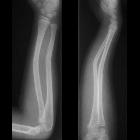greenstick fracture

















 nicht verwechseln mit: Wulstfraktur
nicht verwechseln mit: WulstfrakturGreenstick fractures are incomplete fractures of long bones and are usually seen in young children, more commonly less than 10 years of age. They are commonly mid-diaphyseal, affecting the forearm and lower leg. They are distinct from torus fractures.
Pathology
Mechanism
Greenstick fractures occur when the force applied to a bone results in bending of the bone such that the structural integrity of the convex surface is overcome. The fact that the integrity of the cortex has been overcome results in fracture of the convex surface. However, the bending force applied does not break the bone completely and the concave surface of the bent bone remains intact.
This can occur following an angulated longitudinal force applied down the bone (e.g. an indirect trauma following a fall on an outstretched arm), or after a force applied perpendicular to the bone (e.g. a direct blow).
This fracture is very different, and much less common, than the torus fracture that results in buckling of the cortex on the concave side of the bend and an intact convex surface.
Radiographic features
Plain radiograph
- usually mid-diaphyseal
- occur in tandem with angulation
- incomplete fracture, with cortical breach of only one side of the bone
History and etymology
The fracture resembles the break that results when a supple green branch of a tree is bent and breaks incompletely.
Differential diagnosis
- torus fracture: much more common, metaphyseal, and results in buckling of the cortex
- bowing fracture: the bone is bowed, but there is no discernible fracture
- Salter-Harris fracture
Siehe auch:
und weiter:

 Assoziationen und Differentialdiagnosen zu Grünholzfraktur:
Assoziationen und Differentialdiagnosen zu Grünholzfraktur:

